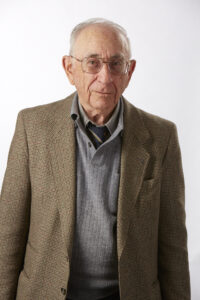03 Sep BPEQ 90th Anniversary: Celebrating Ben Russo


Pictured: Ben Russo (387, Civil)
In 2020, BPEQ turns 90. To celebrate this milestone BPEQ is acknowledging the achievements, projects, innovations, discoveries and stories of RPEQs past and present.
Former RPEQ Rosario ‘Ben’ Russo first became a RPEQ in 1959. In 2015 he was the longest serving RPEQ. Ben retired as a RPEQ in 2018 but left a lasting mark on the profession.
When he was first registered, Sir Robert Menzies was prime minister, the total population of Queensland was just over 1.4 million and engineers relied on a slide-rule or T-square for their design work.
After growing up in Ingham, Ben attended the University of Queensland from 1945 to 1948 where he received his bachelor’s degree in civil engineering. After graduating Ben went on to work in the hydraulics section of the Coordinator General’s Department (originally the Stanley River Works Board).
During his time in government Ben was involved in the design of the Koombooloomba Dam and the Eungella Dam, and the design and construction supervision of the Somerset Dam Hydro-electric Power Station, the Tully Falls Hydro-electric project, the Barron Falls Hydro-electric project and the Collinsville Power-station water supply.
Ben joined the Queensland Irrigation and Water Supply Commission (IWSC) and was an integral part of the design team that worked on Wivenhoe Dam and Burdekin Dam. Following his time at the IWSC, Ben moved into consultancy.
Whilst working Ben also found the time to write a thesis and earn his master’s degree and lecture at the Queensland Institute of Technology (now the Queensland University of Technology) and other learning institutes. In October 1985, he retired from the IWSC, and continued working as a consulting engineer. His clients included the IWSC, the State Electricity Commission, all the Queensland electricity generation authorities, various consulting engineering firms and civil engineering contractors. He conducted annual inspections on all the Brisbane City Council dams until they were taken over by Seqwater, many dam feasibility studies and was involved in the design of Chinaman Creek Dam and the raising of Awoonga Dam.

© The State of Queensland 2016. Eungella Reservoir, Mackay, November 1974. Image courtesy of Queensland State Archives.
‘Whilst working Ben also found the time to write a thesis and earn his master’s degree and lecture at the Queensland Institute of Technology…’
In the latter stages of his career he worked mainly with Sunwater, undertaking comprehensive risk analyses for all their network of 19 dams and the upgrading of those that did not meet current standards.
In his long career Ben experienced many changes in engineering. In Ben’s owns words:
In the early day most junior design engineers did their own drawings, some of which would be traced by draftsmen. There were also draftsmen who were capable of doing design calculations. Although most surveying on construction was done by surveyors, some was done by engineers. For calculations that had to be accurate log tables were used, or desk machines were available that could crank out the answers to simple arithmetic. Handheld electronic calculators were common by the 70s and about the same time IWSC was using the university computer for calculating the stability of earth dams. Micro-computers became available by the end of the 70s, followed by a lot of programs written in Gwbasic or Fortran. Finally, the personal computer and the internet became available and rules supreme today.
This year is a celebration of the achievements, projects, innovations, discoveries and stories of RPEQs past and present. BPEQ encourages RPEQs to share their thoughts –
• What are some of Queensland’s great engineering feats?
• Who was the RPEQ/s who helped deliver the project?
• Are there unsung heroes in the profession?
To have your say contact BPEQ at admin@bpeq.qld.gov.au.

 MY ACCOUNT
MY ACCOUNT
